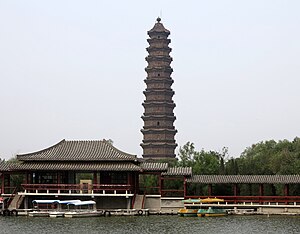Top:The Forbidden City in Beijing, Middle:the Humble Administrator's Garden and the Iron Pagoda, Bottom: The Zhujiajiao God Temple |
Chinese architecture is the embodiment of an architectural style that has developed over millennia in China and has influenced architecture throughout East Asia.[1][2][3][4] Since its emergence during the early ancient era, the structural principles of its architecture have remained largely unchanged. The main changes involved diverse decorative details. Starting with the Tang dynasty,[5] Chinese architecture has had a major influence on the architectural styles of neighbouring East Asian countries such as Japan, Korea, Vietnam, and Mongolia in addition to minor influences on the architecture of Southeast and South Asia including the countries of Malaysia, Singapore, Indonesia, Sri Lanka,[6] Thailand,[7] Laos, Cambodia, and the Philippines.[8]
Chinese architecture is characterized by bilateral symmetry, use of enclosed open spaces, feng shui (e.g. directional hierarchies), a horizontal emphasis, and an allusion to various cosmological, mythological or in general symbolic elements. Chinese architecture traditionally classifies structures according to type, ranging from pagodas to palaces. Due to the frequent use of wood, a relatively perishable material, as well as few monumental structures built of more durable materials, much historical knowledge of Chinese architecture derives from surviving miniature models in ceramic and published diagrams and specifications.
Although unifying aspects exist, Chinese architecture varies widely based on status or affiliation, such as whether the structures were constructed for emperors, commoners, or for religious purposes. Other variations in Chinese architecture are shown in vernacular styles associated with different geographic regions and different ethnic heritages.
The architecture of China is as old as Chinese civilization. From every source of information—literary, graphic, exemplary—there is strong evidence testifying to the fact that the Chinese have always enjoyed an indigenous system of construction that has retained its principal characteristics from prehistoric times to the present day. Over the vast area from Chinese Turkistan to Japan, from Manchuria to the northern half of French Indochina, the same system of construction is prevalent; and this was the area of Chinese cultural influence. That this system of construction could perpetuate itself for more than four thousand years over such a vast territory and still remain a living architecture, retaining its principal characteristics in spite of repeated foreign invasions—military, intellectual, and spiritual—is a phenomenon comparable only to the continuity of the civilization of which it is an integral part.
— Liang Sicheng, 1984[9]
In more recent times, China has become the most rapidly modernizing country in the world. In the past few decades, cities like Shanghai have completely changed their skyline, with some of the worlds tallest skyscrapers dotting the horizon. China also has one of the most extensive high speed rail networks, connecting and allowing its large population to travel more efficiently.
Throughout the 20th century, Chinese architects have attempted to bring traditional Chinese designs into modern architecture. Moreover, the pressure for urban development throughout China requires high speed construction and a greater floor area ratio: thus, in cities the demand for traditional Chinese buildings (which are normally less than 3 levels) has declined in favor of high-rises. However, the traditional skills of Chinese architecture, including major and minor carpentry, masonry, and stonemasonry, are used in the construction of vernacular architecture in China's rural areas.
- ^ L. Carrington Goodrich (2007). A Short History of the Chinese People. Sturgis Press. ISBN 978-1406769760.
- ^ McCannon, John (19 March 2018). Barron's how to Prepare for the AP World History Examination. Barron's Educational Series. ISBN 9780764118166. Archived from the original on 20 March 2018. Retrieved 19 March 2018 – via Google Books.
- ^ Formichi, Chiara (1 October 2013). Religious Pluralism, State and Society in Asia. Routledge. ISBN 9781134575428. Archived from the original on 20 March 2018. Retrieved 19 March 2018 – via Google Books.
- ^ Winks, Robin (21 October 1999). The Oxford History of the British Empire: Volume V: Historiography. OUP Oxford. ISBN 9780191542411. Retrieved 19 March 2018 – via Google Books.
- ^ Steinhardt, Nancy Shatzman (June 2004). "The Tang Architectural Icon and the Politics of Chinese Architectural History". The Art Bulletin. 86 (2): 228–254. doi:10.2307/3177416. ISSN 0004-3079. JSTOR 3177416.
- ^ Bandaranayake, S. D. (19 March 1974). Sinhalese Monastic Architecture: The Viháras of Anurádhapura. BRILL. ISBN 9004039929. Archived from the original on 20 March 2018. Retrieved 19 March 2018 – via Google Books.
- ^ Sthapitanond, Nithi; Mertens, Brian (19 March 2018). Architecture of Thailand: A Guide to Tradition and Contemporary Forms. Editions Didier Millet. ISBN 9789814260862. Archived from the original on 20 March 2018. Retrieved 19 March 2018 – via Google Books.
- ^ ddmdomag (9 April 2013). "Filipino-Chinese Coalitions". openthedorr. Archived from the original on 20 October 2014. Retrieved 9 March 2019.
- ^ Liang Sicheng, year 12, A pictorial history of Chinese architecture : a study of the development of its structural system and the evolution of its types, ed. by Wilma Fairbank, Cambridge (Mass.): MIT Press.



